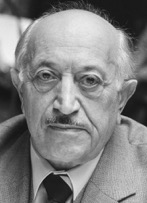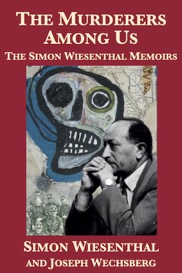
From Janowska Wiesenthal was sent into forced labor at the German Eastern Railways. In 1943 he escaped, but was recaptured; he attempted suicide twice and was sent back to Janowska. After the camp was liquidated the retreating Germans force-marched the less than three dozen remaining inmates (out of more than 100,000) from camp to camp, first to Plaszow, then to Gross-Rosen, to Buchenwald and finally to Mauthausen, Austria where Wiesenthal, having barely survived these hardships, was liberated in May 1945 by the US Army. At 6 feet tall he weighed less than 100 lbs but recovered and was reunited with Cyla at the end of 1945. Like millions of Jews and other ethnic groups murdered by the Nazi regime, dozens of members of his and his wife’s families had died in the camps.
Wiesenthal assisted the War Crimes Section of the US Army and later worked for the US Army’s Office of Strategic Services (OSS) and Counter-Intelligence Corps and headed the Jewish Central Committee of the US Zone of Austria. He also worked for Bricha, a Zionist organization for clandestine immigration to Mandate Palestine. Wiesenthal then dedicated his life to tracking down Nazi war criminals and having them prosecuted. He established the Jewish Documentation Center in Linz (1947-54) where Wiesenthal was vice-president of the local Jewish Community, and worked for the AJDC (Joint Distribution Committee) and ORT (Organization for Rehabilitation through Training) in nearby refugee camps reopened in the 1950s for Jewish and non-Jewish refugees from the Soviet Bloc. Wiesenthal moved his office to Vienna in 1961. In 1953, Wiesenthal learned that Adolf Eichmann, coordinator of the “Final Solution”, was in Argentina and forwarded this information to the Israeli consulate in Vienna. Israel’s intelligence service, the Mossad, captured Eichmann in 1960 in Buenos Aires and brought him to Israel for trial. Found guilty, Eichmann was executed on June 1, 1962.
Wiesenthal’s investigations also led to the capture of other Nazi war criminals, such as Franz Stangl, commandant of the Treblinka and Sobibor extermination camps, Gestapo member Karl Silberbauer who arrested Anne Frank in Amsterdam and Hermine Braunsteiner, a notorious camp guard of the Ravensbrück and Majdanek death camps. Wiesenthal’s house was firebombed in 1982, but no one was injured. He published several books, including The Murderers Among Us: The Simon Wiesenthal Memoirs in 1967, The Sunflower: On the Possibilities and Limits of Forgiveness in 1969 and another memoir, Justice Not Vengeance: Recollections in 1989.
Wiesenthal received many awards and accolades, including the US Congressional Gold Medal of Honor, the Presidential Medal of Freedom, an Honorary Knighthood of the British Empire, the French Legion of Honor, the Dutch Erasmus Prize, the Dutch and Luxembourg Medals of Freedom and the United Nations League for the Help of Refugees Award. His work is recognized for continuing to shed light on the horrors of the Holocaust, for calling on governmental intervention in the capture of war criminals. Wiesenthal is remembered as a driven, at times a sole, investigative force. He helped expose Odessa, the organizations which helped former Nazis escape to South America and his work, including his efforts to find prosecution witnesses, is said to have helped bring 1,100 former Nazis to trial.
The Simon Wiesenthal Center, founded in November 1977 in Los Angeles, is an international center for Holocaust Remembrance, defense of human rights and the Jewish people. The Vienna Wiesenthal Institute for Holocaust Research, which contains his archive, opened in 2017.
Click on each cover for details about each eBook:





